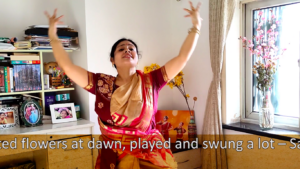
[the_ad_placement id=”adsense-in-feed”]
Exclusive
 -By Suvam Pal* in Beijing
-By Suvam Pal* in Beijing
Documentary Title: Gitanjali (Song offering)
Duration:9 minutes
Language: Bengali & Mandarin (English subtitles)
Purpose: A tribute to Gurudev Rabindranath Tagore on his 159thbirth anniversary; the 70thanniversary of India & China diplomatic relations.
I am a Beijing-based author and media professional. On first of May it came to my mind that let’s do something for India’s first-ever Nobel laureate and multi-faceted polymath Gurudev Rabindranath Tagore, and celebrate the 70th anniversary of establishment of diplomatic ties between India and China.
So I embarked on directing this documentary. Gitanjali is a unique micro-documentary made within a week to mark the 159thbirth anniversary of Tagore (which falls on 8th May). It’s a complete ensemble of poetry, song, music, dance and art dedicated to the man, who was an iconic poet, novelist, playwright, musician and artist and played a pivotal role in building a golden bridge between the two ancient civilizations and neighbours for ages.
[the_ad_placement id=”content-placement-after-3rd-paragraph”]
 Tagore came to my mind because in last four years that I have been living in China, I could make out that the most famous, the most popular and probably the only Indian before Amir Khan became popular, the Chinese always fondly remembered is Tagore. So that’s why it kicked to my mind. I thought let’s do something and since I am sitting at home because of the lockdown why not make something that can relate to both Tagore and the 70th anniversary of India-China diplomatic relations? And that’s how it started. Another thing that came to my mind was after watching many people making cooking, singing, dancing, recitation videos and all, so I thought I could do something. I am not a good singer, I am not a good dancer, I am not a good cook, but I can do something so let’s make a film. This is a big year in terms of India-China diplomatic relations, so let’s do something that could be meaningful for society.
Tagore came to my mind because in last four years that I have been living in China, I could make out that the most famous, the most popular and probably the only Indian before Amir Khan became popular, the Chinese always fondly remembered is Tagore. So that’s why it kicked to my mind. I thought let’s do something and since I am sitting at home because of the lockdown why not make something that can relate to both Tagore and the 70th anniversary of India-China diplomatic relations? And that’s how it started. Another thing that came to my mind was after watching many people making cooking, singing, dancing, recitation videos and all, so I thought I could do something. I am not a good singer, I am not a good dancer, I am not a good cook, but I can do something so let’s make a film. This is a big year in terms of India-China diplomatic relations, so let’s do something that could be meaningful for society.
 Since I am from Santi Niketan, from Viswa Bharti University — I spent almost 15 years of my life there, so Tagore was always in my mind and when I saw Chinese people — they love Tagore so much, I thought let’s do something through this so that I can cover the lockdown situation as well as diplomacy, as well as everything. Even today in China, primary schools or junior schools teach Tagore’s poems in Chinese. Except Bangladesh I don’t think any other country has spent so much time on research on Tagore than China. Tagore is still standing tall between the two countries and he is the most revered and respected icon in both countries.
Since I am from Santi Niketan, from Viswa Bharti University — I spent almost 15 years of my life there, so Tagore was always in my mind and when I saw Chinese people — they love Tagore so much, I thought let’s do something through this so that I can cover the lockdown situation as well as diplomacy, as well as everything. Even today in China, primary schools or junior schools teach Tagore’s poems in Chinese. Except Bangladesh I don’t think any other country has spent so much time on research on Tagore than China. Tagore is still standing tall between the two countries and he is the most revered and respected icon in both countries.

The language of the first-of-its-kind film are Bengali and Mandarin with the students and scholars from various cities in China paying their heartfelt tributes in Tagore’s mater lingua Bengali while the Indian students and academics showcasing their love for the beloved bearded bard and his profound message of camaraderie to the people of the world’s most populous nation in Mandarin. Created by eminent percussionist and a guest faculty from China’s prestigious Central Conservatory of Music in Beijing, the never-seen-before musical melange is comprised of one of the most popular Indian string instruments of Sitar, Tabla, a common percussion instrument in Indian classical music, Esraj, a rare Indian string instrument predominantly used in Rabindra Sangeet, and a slew of traditional Chinese instruments like Pipa, Guzheng and Yangqin, alongside popular western instruments like Piano and Guitar.
 Beijing-based Bharatnatyam exponent Jin Shanshan specially created her dance moves following the style of Rabindra Nritya, a traditional dance genre from Santiniketan, for the first time in her decades long career as a danseuse. One of the finest Indian classical dancers in China and Tsinghua University scholar, Reshmita Nath danced to a Tagore classic, sung by a group of Chinese students studying Bengali. Shenzhen-based Graphics designer Qin Xiaoping, who studied fine arts in Visva-Bharati, Santiniketan a couple of decades ago and has been quite a great admirer of its founder since then, used the Chinese pen drawing style to draw a portrait of a versatile Tagore, who started painting after the age of 60.
Beijing-based Bharatnatyam exponent Jin Shanshan specially created her dance moves following the style of Rabindra Nritya, a traditional dance genre from Santiniketan, for the first time in her decades long career as a danseuse. One of the finest Indian classical dancers in China and Tsinghua University scholar, Reshmita Nath danced to a Tagore classic, sung by a group of Chinese students studying Bengali. Shenzhen-based Graphics designer Qin Xiaoping, who studied fine arts in Visva-Bharati, Santiniketan a couple of decades ago and has been quite a great admirer of its founder since then, used the Chinese pen drawing style to draw a portrait of a versatile Tagore, who started painting after the age of 60.


The passion project is a collaboration by a wide range of students, scholars and faculty members from China’s Peking University, Tsinghua University, Communication University of China, Yunnan Minzu University, UK’s University of Bath, and India’s Visva-Bharati and Doon University, as well as professionals from more than 10 different cities in India and the United Kingdom, which are grappling with the COVID-19-forced lock-down, and China, which is recovering rapidly from the pathogenic pandemic.
As is obvious, there were many challenges in making this documentary. The biggest problem I faced while making this  documentary was that my concept had to be executed through a group of people — Indian and Chinese. And since China is not yet under complete lockdown but most of the people are sitting at home, and they can’t really go out for shoot; and india is completely under lockdown so that was the biggest challenge to get everybody. So that’s why some of the biggest challenges was for example there was a song I thought of getting it sung one after another line by different people. For that you had to set scale. I asked people to self record their videos but you had to set the same scale for everybody. That was the biggest challenge. I asked people to self record their videos and then send it to me. But before self recording I told them to follow certain formats. So getting the things done by 25 people from 15 cities was difficult.The entire project is separately shot by each of the performers from their respective homes using their individual mobile phone cameras in Delhi, Mumbai, Dehradun, Bengaluru, Bolpur-Santiniketan, Jorhat, Bath, Beijing, Shanghai, Shenzhen, Yuncheng and Kunming.
documentary was that my concept had to be executed through a group of people — Indian and Chinese. And since China is not yet under complete lockdown but most of the people are sitting at home, and they can’t really go out for shoot; and india is completely under lockdown so that was the biggest challenge to get everybody. So that’s why some of the biggest challenges was for example there was a song I thought of getting it sung one after another line by different people. For that you had to set scale. I asked people to self record their videos but you had to set the same scale for everybody. That was the biggest challenge. I asked people to self record their videos and then send it to me. But before self recording I told them to follow certain formats. So getting the things done by 25 people from 15 cities was difficult.The entire project is separately shot by each of the performers from their respective homes using their individual mobile phone cameras in Delhi, Mumbai, Dehradun, Bengaluru, Bolpur-Santiniketan, Jorhat, Bath, Beijing, Shanghai, Shenzhen, Yuncheng and Kunming.

In this documentary, the age of the performers for the project varies from nine to ninety one, highlighting Tagore’s works transcending ages and generations. Notably, some parts of a poem from one of Tagore’s anthologies, Stray Birds (Kanika in Bengali), a Mandarin translation of which is extremely popular in China for decades, has been recited in Chinese by Deborshmi Nath, a 9-year-old Indian student from Beijing, while a 91-year-old Professor Tan Chung, an eminent historian and son of late Professor Tan Yun-Shan, the founder of Cheena Bhavan in Visva-Bharati, Santiniketan, shared his pearls of wisdom on the Indian literature colossus, who visited China in 1924 and 1929 and was presented with the Chinese name of Zhu Zhendan on his 64thbirthday.

In fact, even after 79 years since he breathed his last, Tagore has been standing tall as the most prominent and pioneering cultural ambassador between the current Sino-Indian interface and has still been playing a pivotal role in consolidating the timeless bridge of friendship.
It’s a special tribute to Tagore by his admirers in both India and China as we have also made an effort to re-calibrate our story-telling process under the new normal due to COVID-19.
*Suvam Pal is a Beijing-based media professional and author[the_ad_placement id=”sidebar-feed”]






Like!! Thank you for publishing this awesome article.
I learn something new and challenging on blogs I stumbleupon everyday.
I always spent my half an hour to read this web site’s articles or reviews daily along with a mug of coffee.
Thanks so much for the blog post.